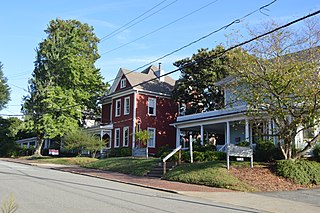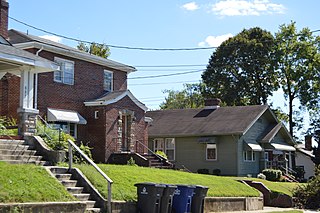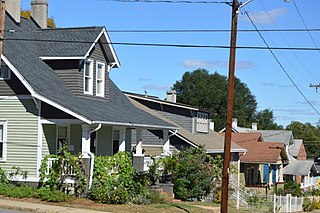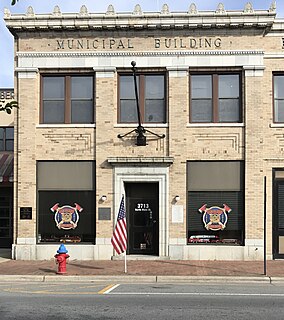
Old Salem is a historic district of Winston-Salem, North Carolina that was originally settled by the Moravian community in 1766 . This small city features a living history museum that interprets the restored Moravian community. The non-profit organization began its work in 1950, although some private residents had restored buildings earlier. As the Old Salem Historic District, it was declared a National Historic Landmark (NHL) in 1966. and expanded in 2016. The district showcases the culture of the Moravian settlement in North Carolina during the 18th and 19th centuries, communal buildings, churches, houses, and shops.

The Single Brothers' House was built to house the Single Brethren, the unmarried men, of the Moravian Congregation of Salem, now Winston-Salem, North Carolina. It is part of Old Salem Museums & Gardens and open as an Old Salem tour building to visitors. It is located at 600 South Main Street, at Academy Street, on the southwest corner.

Salem Street Historic District is a national historic district located at Thomasville, Davidson County, North Carolina, United States. The district encompasses 33 contributing buildings in a predominantly residential section of Thomasville. They were built between about 1861 and 1957, and include notable examples of Queen Anne and Colonial Revival style architecture. Notable buildings include the Heidelberg Church, St Paul's Episcopal Church, White House, Strickland-Long House, Morris-Harris House, and Leon A. Kress House.

West Durham Historic District is a national historic district located at Durham, Durham County, North Carolina. The district encompasses 101 contributing buildings in a mixed industrial, commercial, and residential section of Durham. The buildings primarily date after 1892 and include notable examples of Classical Revival, Italianate, and Queen Anne architecture. Located in the district is the separately listed Erwin Cotton Mills Company Mill No. 1 Headquarters Building. Other notable buildings include Erwin Cotton Mills Co. Mill No. 4 (1909–10), Erwin Cotton Mills Co. worker's housing (1910s), Fidelity Bank (1920s), E. K. Powe School (1928), Blacknall Memorial Presbyterian Church (1922), and St. Joseph's Episcopal Church.

Downtown North Historic District, also known as Trade Street District, is a national historic district located at Winston-Salem, Forsyth County, North Carolina. The district encompasses 46 contributing buildings in a commercial section of Winston-Salem. They were built between about 1907 and 1952, and most are one- or two-story brick buildings, sometimes with a stuccoed surface. Notable buildings include the Beaux-Arts style former United States Post Office with an addition by Northup and O'Brien, Brown-Rogers-Dixson Company Building (1928), Centenary Church Education Building (1920s), Pure Oil Station, City Market (1925), and Twin City Motor Company (1925).

Holly Avenue Historic District is a national historic district located at Winston-Salem, Forsyth County, North Carolina. The district encompasses 115 contributing buildings and 1 contributing site in a predominantly residential section of Winston-Salem. The buildings date between about 1885 and 1952, and include single family dwellings and apartment building. The include examples of late-19th and early-20th popular architectural styles including the Queen Anne and Italianate style. Notable buildings include the Henry Case House, James Jessup House, Henry Foltz bam (1906), Calvary Moravian Church (1923), T. R. Brann's store, and Green Front Grocery.

North Cherry Street Historic District is a national historic district located at Winston-Salem, Forsyth County, North Carolina. The district encompasses 62 contributing buildings and 1 contributing object in a historically African-American residential section of Winston-Salem. The buildings date from about 1925 to 1951, and include notable examples of Colonial Revival and Bungalow / American Craftsman style architecture.

Reynoldstown Historic District, also known as Cameron Park, is a national historic district located at Winston-Salem, Forsyth County, North Carolina. The district encompasses 183 contributing buildings and 1 contributing structure in a planned residential development of the R. J. Reynolds Tobacco Company (RJR) and historically African-American residential section of Winston-Salem. The buildings date from about 1919 to 1949, and include notable examples of Colonial Revival, Tudor Revival, and Bungalow / American Craftsman style architecture.

Sunnyside-Central Terrace Historic District is a national historic district located at Winston-Salem, Forsyth County, North Carolina. The district encompasses 425 contributing buildings in a predominantly residential section of Winston-Salem. The buildings date from about 1892 to 1958, and include notable examples of Colonial Revival, Late Victorian, and Bungalow / American Craftsman style architecture. Notable buildings include the Arista Mills (1950), Farmers Cooperative Exchange, Southern Steel Stampings, E. T. Baity Oil Co., Central Terrace Methodist Church, and Pine Chapel Moravian Church (1928).

Washington Park Historic District, also known as the Southside Neighborhood, is a national historic district located at Winston-Salem, Forsyth County, North Carolina. The district encompasses 348 contributing buildings, 1 contributing site, and 2 contributing structures, in a predominantly residential section of Winston-Salem. It was a planned speculative development centered on a streetcar line. The buildings date from about 1892 to 1940, and include notable examples of Colonial Revival, Queen Anne, and Bungalow / American Craftsman style architecture. Notable buildings include the Schlatter Memorial Reformed Church (1916).

Waughtown-Belview Historic District is a national historic district located at Winston-Salem, Forsyth County, North Carolina. The district encompasses 1,137 contributing buildings, 1 contributing site, and 1 contributing object in a largely residential section of Winston-Salem. The buildings date from about 1834 to 1955, and include notable examples of Greek Revival, Colonial Revival, Queen Anne, and Bungalow / American Craftsman style architecture. Located in the district is the separately listed Shell Service Station. Other notable resources include the Clodfelter House, Fiddler House, Nissen Wagon Works smokestack, Triangle Body Works, Waughtown Baptist Church (1919), Waughtown Presbyterian Church (1914), Southside Christian Church, and Waughtown Cemetery.

Winston-Salem Tobacco Historic District is a national historic district located at Winston-Salem, Forsyth County, North Carolina. The district encompasses 16 contributing buildings and 16 contributing structures in a predominantly industrial section of Winston-Salem. The buildings date from about 1890 to 1959, and include buildings relating to the tobacco industry, specifically R. J. Reynolds Tobacco Company. Also on the district are a once-thriving African American and the wholesale commercial business district that once catered to the R. J. Reynolds Tobacco Company workers. Located in the district is the separately listed Romanesque Revival style S. J. Nissen Building and Piedmont Leaf Tobacco Company.

West Salem Historic District is a national historic district located at Winston-Salem, Forsyth County, North Carolina. The district encompasses 591 contributing buildings, 1 contributing site, and 3 contributing structures in a largely residential section of Winston-Salem. The buildings date from about 1843 to 1957, and include notable examples of Colonial Revival, Queen Anne, and American Craftsman style architecture, as well as bungalows. Notable resources include the M. D. Gantt Building (1931), Coca-Cola Bottling plant (1930), Christ Moravian Church (1895), and Green Street Methodist Church (1921).

Louisburg Historic District is a national historic district located at Louisburg, Franklin County, North Carolina. The district encompasses 206 contributing buildings, 1 contributing site, 6 contributing structures, and 1 contributing object in residential sections of Louisburg included in the original 1779 town plan. It also includes a section of Louisburg College located on the old Town Commons. Dwellings date between about 1800 and the 1920s and include notable examples of popular architectural styles including Federal / Georgian, Italianate / Greek Revival, Queen Anne, Colonial Revival, Late Victorian, and Bungalow / American Craftsman. Located in the district and separately listed are the Fuller House, Williamson House, and Main Building, Louisburg College. Other notable buildings include the Shine-King House, Milner-Perry-Boddie-Dennis House, Dr. J.B. Clifton House, The Edgerton-Pruitt House, The Furgurson-Hicks House, Nicholson-Bickett-Taylor House, The Hughes-Watson-Wheless House, Bailey-Yarborough House, The Barrow House, The Neal-Webb House, The Milner-Williams-Person Place, Former Rectory-St. Paul's Episcopal Church, Hicks-Perry-Bland-Holmes House, Malcomb McKinne House First Baptist Church (1927), Louisburg United Methodist Church (1900), and Louisburg Baptist Church (1901-1904).

Oxford Historic District is a national historic district located at Oxford, Granville County, North Carolina. The district encompasses 201 contributing buildings, 1 contributing site, and 2 contributing objects in the central business district and surrounding residential sections of Oxford. It includes buildings dating from the early-19th century through the 1930s and notable examples of Greek Revival and Late Victorian style architecture. Located in the district is the separately listed Granville County Courthouse (1838-1840). Other notable buildings include the Bryant-Kingsbury House, Taylor-McClanahan-Smith House (1820s), former Granville County Jail, Oxford Women's Club, Titus Grandy House (1850s), Oxford Presbyterian Church, St. John's College, Lyon-Winston Building (1911), Herndon Block Number 2, Hunt Building, L. H. Currin-American Tobacco Company (1860s), and St. Stephens Episcopal Church (1902).

Chapel Hill Historic District is a national historic district located at Chapel Hill, Orange County, North Carolina. The district encompasses 46 contributing buildings, 2 contributing structures, and 2 contributing objects on the central campus of the University of North Carolina at Chapel Hill and surrounding residential sections of Chapel Hill. The district's buildings date from 1795 to the early-20th century and include notable examples of Classical Revival and Jacobean Revival architecture. Located in the district and separately listed are the Chapel of the Cross, Old East, building and Playmakers Theatre. Other notable contributing resources are the Davie Poplar, Old West (1822), South Building (1798), the Old Well, Person Hall (1797), Gerrard Hall (1822), New East, New West, the Joseph Caldwell Monument (1858), the Y.M.C.A. Building, Battle-Vance-Pettigre11 Dormitory (1913), Horace Williams House (1854), the Phillips Law Office, the Phillips House (1856), the Old Methodist Church (1853), Senlac, Hippol Castle (1920s), and Battle Park.

Farmville Historic District is a national historic district located at Farmville, Pitt County, North Carolina. The district encompasses 330 contributing buildings, 1 contributing site, and 2 contributing structures in the central business district and surrounding residential sections of Farmville. It includes buildings dated from about 1860 to 1942 and notable examples of Colonial Revival, Classical Revival, and Queen Anne style architecture. Notable buildings include the James W. May House, Fields-Rasberry House, Dr. David Morrill House, Warren Parker House, Nannie Smith House, First Christian Church (1910), Emmanuel Episcopal Church (1920), St. Elizabeth Catholic Church, Municipal Building (1928) possibly designed by Benton & Benton, Bank of Farmville (1921) designed by Benton & Benton, Pollard Auto Company Building, Paramount Theatre (1930s), J. Y. Monk Tobacco Warehouse, and East Carolina Railway Office and Freight Station.

Reidsville Historic District is a national historic district located at Reidsville, Rockingham County, North Carolina. It encompasses 324 contributing buildings, 1 contributing site, 11 contributing structures, and 1 contributing object in the central business district and surrounding residential sections of Reidsville. It was developed between about 1865 and 1941, and includes notable examples of Italianate, Queen Anne, American Craftsman, and Classical Revival style architecture. Located in the district are the separately listed Penn House and Gov. David S. Reid House. Other notable buildings include the Oaks-Motley House, Colonel A. J. Boyd House (mid-1870s), Reid Block (1880s), Citizens' Bank Building, William Lindsey and company Tobacco Factory, First Baptist Church, Main Street Methodist Church, Melrose (1909) designed by architect Richard Gambier, R. L. Watt house designed by Willard C. Northup, First Presbyterian Church (1922), St. Thomas Episcopal Church, Grand Theatre, Belvedere Hotel, United States Post Office and Federal Building, and the Municipal Building (1926).

West Main Street Historic District is a national historic district located at Forest City, Rutherford County, North Carolina. It encompasses 27 contributing buildings, 1 contributing site, and 1 contributing object in a predominantly residential section of Forest City. The district developed after 1867, and includes notable examples of Colonial Revival and Bungalow / American Craftsman style architecture. Located in the district is the separately listed Cool Springs High School designed by Louis H. Asbury (1877-1975). Other notable contributing resources include the Cool Springs Cemetery, First Presbyterian Church (1940), the Cool Springs Gymnasium (1958), Lovelace-Ragin House (1928), Harrill-Wilkins House (1925), Frank B. and Mae Bridges Wilkins House, McDaniel House (1913), Biggerstaff-Griffin House (1925), and McMurry-Bodie House (1928).

West Main–North Chesnutt Streets Historic District is a national historic district located at Clinton, Sampson County, North Carolina. The district encompasses 44 contributing buildings in a predominantly residential section of Clinton. It developed between about 1830 to the early 1930s, and includes notable examples of Greek Revival, Colonial Revival, and Gothic Revival architecture. Notable buildings include the Richard Clinton Holmes House, Amma. F. Johnson House (1868), Dr. William G. Micks House (1851), William Hubbard House, R. H. Hubbard, Sr. House, St. Paul's Episcopal Church (1902), L. C. Graves Presbyterian Church (1908), C. B. Barrus House (1923), the Hathcock-Hobbs House, the Gabe Barbrey House (1932), and the F. L. Turlington House (1937).






















